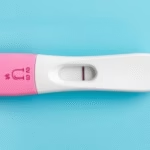Understanding Late Implantation Bleeding
Late implantation bleeding refers to light spotting or bleeding that can occur when a fertilized egg attaches itself to the lining of the uterus. This event happens typically between one to two weeks after conception, but in some cases, it can occur slightly later. Many may not recognize this phenomenon since it can be easily mistaken for an early period or other types of bleeding during pregnancy.
The understanding of late implantation bleeding is crucial for early pregnancy awareness, as it may be one of the first signs of pregnancy for some individuals. It generally appears as light pink or brownish discharge and is not accompanied by severe cramping or heavy bleeding, which is often indicative of menstruation or complications. Recognizing this bleeding can assist individuals in confirming their pregnancy and seeking appropriate prenatal care. By understanding what late implantation bleeding is, individuals can be more in tune with their bodies and the signs of early pregnancy.
Subtopic 1: The Timing of Implantation Bleeding
Timing is a significant factor that differentiates late implantation bleeding from other types of bleeding. Implantation occurs about 6-12 days after fertilization, and late implantation bleeding may happen within the two weeks following. This period is when the hormone levels begin to change significantly, impacting the lining of the uterus and causing the potential for light spotting.
Individuals tracking their menstrual cycle can use this timing to gauge if they may be experiencing late implantation bleeding. For those expecting their periods, recognizing that their cycle may be off by a week or more may alert them to the possibility of pregnancy. This awareness can encourage seeking a pregnancy test for confirmation.
Experience with late implantation bleeding varies. Some may notice spotting as early as 6 days post-ovulation, while others may also see it as late as 14 days. Understanding that this timing can vary helps in discerning between other signs of menstruation and implantation bleeding.
Signs and Symptoms of Late Implantation Bleeding
Identifying the signs and symptoms of late implantation bleeding can clarify whether one is experiencing early pregnancy symptoms or simply a variation of their menstrual cycle. Light spotting is the primary symptom of late implantation bleeding. It is often confused with a light period but tends to be lighter in color and flow.
Other accompanying signs can include:
It is essential to note that these symptoms can also resemble those of premenstrual syndrome (PMS), making recognition challenging. The critical difference lies in the timing and intensity of the symptoms. Late implantation bleeding generally does not present with the cramping that many associate with a menstrual cycle.
How to Differentiate Between Late Implantation Bleeding and Menstrual Bleeding
Understanding the differences is vital for anyone who is sexually active and tracking their cycle. Late implantation bleeding usually appears close to the expected period but behaves differently in terms of discharge and accompanying symptoms.
Key identifiers include:
Paying attention to these characteristics can be particularly helpful for those wondering if their recent bleeding is a potential sign of pregnancy.
The Role of Hormones in Implantation Bleeding
Hormones significantly impact the development and sustainability of early pregnancy, including symptoms like late implantation bleeding. When the fertilized egg implants into the uterine lining, a rise in the hormone human chorionic gonadotropin (hCG) triggers various physiological changes.
This surge in hormones causes changes in the blood flow to the uterine lining, which may be responsible for the light spotting that some associate with late implantation bleeding. Other hormones, such as progesterone and estrogen, play a role in thickening the uterine lining and maintaining early pregnancy, thereby influencing the occurrence of such bleeding.
Awareness of how these hormones function can help those trying to conceive to better understand their bodies and the potential signs of pregnancy.
When to Consult a Healthcare Provider
For many, late implantation bleeding may be a minor occurrence that doesn’t warrant medical attention. However, conditions that could signal complications, such as heavy bleeding, severe cramping, or symptoms of an ectopic pregnancy, require immediate consultation with a healthcare provider.
Key indicators to watch for include:
Understanding Pregnancy Tests After Late Implantation Bleeding
For those who suspect pregnancy post-late implantation bleeding, understanding when to take a pregnancy test is essential. Generally, it is advised to wait until the first day of a missed period for the most accurate results. This timing coincides with both an increased hCG level in the urine and the heightened likelihood of confirming pregnancy.
For those who may want to test earlier, home pregnancy tests can sometimes detect hCG levels as soon as five to seven days after conception. Individuals utilizing these tests during this time should be aware of the potential for false negatives, owing to lower levels of the hormone.
Myths and Facts About Late Implantation Bleeding
Several myths surround late implantation bleeding, leading to confusion and misinformation. Understanding these misconceptions helps clarify what is scientifically accurate.
Common myths include assumptions that:
Research indicates that late implantation bleeding is a common occurrence and not indicative of anything unusual in a healthy pregnancy.
Final Thoughts
Late implantation bleeding is a critical sign for those trying to understand the early stages of pregnancy. This phenomenon typically occurs when a fertilized egg attaches to the uterus and can happen anywhere from one to two weeks post-fertilization. Understanding its signs, timing, and how it relates to menstruation can provide clarity for many.
Apart from spotting, hormonal changes play a crucial role in early pregnancy indications. By recognizing the risks and knowing when to consult a healthcare professional, individuals can navigate early pregnancy with more confidence. Myths surrounding late implantation bleeding can further cloud understanding; hence, correcting this misinformation is vital for those exploring potential pregnancy. Rigorous tracking of cycles and symptoms enhances awareness and aids in recognizing these early signs.
Ultimately, being informed about late implantation bleeding can pave the way for a healthy start to pregnancy. Balancing knowledge and awareness with regular consultations can significantly improve outcomes for those hoping to conceive.
Frequently Asked Questions
1. What exactly is late implantation bleeding?
Late implantation bleeding is light spotting that occurs when a fertilized egg attaches itself to the uterine lining, typically between one to two weeks after conception.
2. How do I know if it is implantation bleeding?
Implantation bleeding is usually light pink or brown and appears as spotting rather than a regular period. It typically lasts for a day or two.
3. Can I take a pregnancy test after experiencing late implantation bleeding?
Yes, you can take a pregnancy test after late implantation bleeding; for the most accurate results, however, waiting until the first day of your missed period is advised.
4. Is late implantation bleeding a cause for concern?
In most cases, late implantation bleeding is normal and not a cause for concern unless accompanied by severe cramping or heavy bleeding.
5. When should I see a doctor about bleeding?
Consult a healthcare provider if the bleeding is heavy, contains large clots, or is accompanied by severe abdominal pain, as these signs may indicate complications.
Further Reading
What Type of Psychotherapy Is Best for Anxiety?







